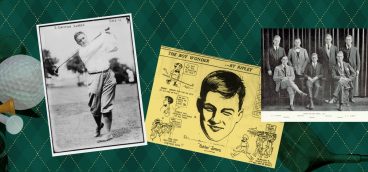The Seniors Come to Pittsburgh

As public relations announcements go, this one was so benign, so coolly and corporately efficient, it might have been an update on pork belly and potassium futures:
Pittsburgh, Pa. and Ponte Vedra Beach, Fla.—The Constellation Senior Players Championship and the PGA Tour’s Champions Tour announced today that the tournament will move to Fox Chapel Golf Club in Pittsburgh in 2012.
This came last Dec. 21, and the tournament would be played June 28–July 1, so for Western Pennsylvania golf fans, it was like getting hit on the head by a Christmas piano. Big-time golf was coming back to town—Fred Couples, Bernhard Langer, Mark Calcavecchia, Kenny Perry, Greg Norman and the boys.
The Senior Players is the flagship event of the Champions Tour (formerly known as the Senior Tour, for the 50-and-over set). It’s one of the five majors on the tour, but it’s the tour’s own—the equivalent of the Players Championship of the parent PGA Tour. And with a purse of $2.7 million, it is the richest full-field tournament on the tour. The purse is matched only by the Liberty Mutual Insurance Legends of Golf, a kind of rich exhibition, a limited-field tournament for two-man teams.
All of this raised eyebrows to the roof when the Senior Players was announced on such short notice. When it comes to staging a golf tournament, six months from announcement to tee-off is warp speed.
Fox Chapel President Arthur Scully was still trying to catch his breath. “These things,” he noted, “are usually announced well in advance—years in advance.”
A tournament of this magnitude is hardly a fish fry. It’s an immense undertaking. There’s infra to be structured—building grandstands, laying TV cables, assembling an army of volunteers for crowd control, arranging transportation for fans, and erecting hospitality tents, those comfy schmooze shelters where companies can pay up to $65,000 to get clients in out of the golf. But first of all, there was the big question that faces all clubs: Would the members be willing to give up their club for a few weeks? It’s like letting visitors have the run of your house.
“I guess there were a few complaints,” Scully said, “but the support was overwhelming.”
Said tournament co-chair Courtney Myhrum, noted for her work with the U.S. Golf Association: “Our members are going to see things they’ve never seen before.”
Why Fox Chapel? And why now?
First, a brief history lesson.
Age had caught up with all of the golfers of yesteryear. As Lee Trevino put it: “All my old girlfriends have blue hair now.”
The golfers’ careers were over. But suddenly another chance emerged. It was called the “great mulligan,” borrowing from that delightful practice in informal golf of taking another shot if you didn’t like the first one. This was the Legends, an unofficial tournament for the older guys, launched in 1978. It was a smash. Old football and baseball heroes would embarrass themselves, but the golfers could play on. Off that boffo performance, the Senior Tour was born in 1980. Two majors were already in place, both because they were long-established championships from two of golf’s organizations—the U.S. Senior Open, staged by the U.S. Golf Association, and the Senior PGA Championship, by the PGA of America. Three tournaments were simply christened as “majors” by the Senior Tour—the Legends, because it had spawned the tour; the Tradition, because the tour said so to a well-heeled sponsor, and the Senior Players Championship, because it was the tour’s own. The Senior Players debuted in 1983, and Fox Chapel will be the ninth venue in 30 playings. Last year, at Westchester Country Club, near New York City, Freddie Couples flipped a wedge to three feet and beat John Cook with a birdie on the second playoff hole.
The Senior Tour, by the way, was renamed the Champions Tour in 2002. It sounded better.
So why Fox Chapel, and why now?
For one thing, the sponsor’s wishes. Baltimore-based Constellation Energy had merged with Chicago-based energy giant Exelon Corp. and wanted a venue somewhere between the two. “They felt Pittsburgh, with its energy boom, and sitting about halfway between Chicago and Baltimore, would be an ideal location,” Scully said. “And also, Pittsburgh has a long history of staging major championships. They also wanted to get away from cookie-cutter courses. They wanted a classic golf course.”
But a more pressing reason is that the Senior Players is a tournament in search of respect. The Champions Tour wants it to be held in the highest regard, like, say, the U.S. Senior Open. But as with The Players Championship on the parent PGA Tour, it just doesn’t seem to make it.
“We are trying to raise the stature of this event,” said Mike Stevens, president of the Champions Tour.
Lord knows all the marquee ingredients are all there: The biggest purse, a classy full field of 78 for four rounds, and no 36-hole cut to carry away any errant stars.
The equation is fundamental: Stature is a matter of perception, and perception is reality. So Fox Chapel in mid-summer has become the tour’s big bet.
It’s tough for any golf event to get attention and attendance in late summer or in the fall. The competition from America’s other pastimes is stiff. Note that the Nationwide Tour’s Mylan Classic at Southpointe, Aug. 30–Sept. 2, has to go against the Steelers, Pitt and the Pirates. The Senior Players at Westchester last August came up against the Yankees and the Mets and the start of the pro football season. Before that, the tournament was at Baltimore Country Club, with the Ravens and the Orioles for company. Hence the date change to mid-summer. The tournament could co-exist with the Pirates.
Next, the tour needed fan appreciation.
“Given the history of Pittsburgh—the City of Champions—and how the fans supported all the sports, and supported the U.S. Opens at Oakmont and the Mylan Classic,” said Stevens, “we felt this move would give us the opportunity to raise this event.”
The Senior Players will be the first pro men’s event ever at Fox Chapel, joining the two previous national tournaments, the 1965 U.S. Senior Amateur, won by Robert Kiersky, and the 1985 U.S. Women’s Amateur, won by Japan’s Michiko Hattori. Fox Chapel also hosted the 2002 Curtis Cup, the match between American and British-Irish amateur women. The U.S. won, led by Sewickley’s Carol Semple Thompson, who was elected to the World Golf Hall of Fame in 2008.
In western Pennsylvania golf history, the Senior Players will take its place alongside the U.S. Opens, the PGA Championships, the Ben Hogan Tour stops at Quicksilver Golf Club and the Quicksilver Senior Classic in the 1990s, and all the others.
Fox chapel golf club was born of socio-political friction. One fine day in 1910, Pittsburgh Mayor William A. Magee—a Republican, incidentally—evicted the Pittsburgh Golf Club from the Schenley Park golf course, a course they had built over the years. It seems the Pittsburgh Golf Club, which once counted Andrew Mellon and Henry Clay Frick among its members, were squatters. Mayor Magee was returning the park to the people of Pittsburgh, to whom Mary Schenley had left it. Some homeless PGC members joined Oakmont, some Allegheny. “But,” says the Fox Chapel history, “…all felt we ought not be playing on other people’s courses, but should have one all our own.” Fox Chapel was born and opened for play June 13, 1925.
Among golf connoisseurs, there is more than the usual excitement over this tournament. Fox Chapel is famed as a classic example of the artistry of Seth Raynor, a premier course architect of the early 20th century. If Fox Chapel were a car, it would be a Bugatti; if a violin, a Stradivarius. Fox Chapel isn’t the epic challenge of, say, a Ross (Pinehurst No. 2), a Tillinghast (Winged Foot) or a Mackenzie (Augusta National). Those architects were heavy on the timpani and cymbals. Raynor wrote for strings.
Fox Chapel is a bloodline course that has its roots in one Charles Blair Macdonald, of Chicago, known as the Father of American Golf Course Architecture. His ego and arrogance led to the founding of the U.S. Golf Association. Raynor, a civil engineer from Long Island, was his protégé. Raynor so admired Macdonald that he once said he wished he’d had donkey ears so that he wouldn’t have missed a word. Raynor’s admiration manifested itself in another way, too.
Macdonald admired—almost worshiped—certain golf holes he’d seen on his visits to Britain. He used them in his courses. Raynor, in turn, so admired Macdonald’s that he also used them. It seems they had a kind of inventory of 20 or so holes to be used as the mood and topography struck them. Careful, though—purists fly into a tizzy if anyone refers to them as “copies.” It seems safe to call them “template holes.” But they sure look like copies.
For all of that, Raynor wanted golfers to have fun. And he had fun with golfers.
Fox Chapel will play to a par of 70 and its length, only some 6,700 yards, will not test these guys.
“I’ve lost some swing speed,” said John Huston, “but with today’s technology, I can still get it out there 295 yards. Putting is my biggest difficulty now.”
Putting is like poison ivy. It’s always a problem.
The pros will be playing pretty much the same course the Fox Chapel members play.
“The fairways are wide and should be no great problem,” said Fox Chapel pro Alexander Childs. “So the tournament might well be decided on the greens, especially the par-threes. As good as these guys are, they have a great advantage when they can put the ball on a tee. So I wouldn’t expect any of the hole locations to be in the center of the green on the par-threes. And the greens are tricky, and they can be made pretty fast.”
Architecturally, as Childs sees it, Raynor built an intriguing harmony into the course. For example, No. 1 is a healthy but not intimidating par-4 of 418 yards. It’s a possible birdie, almost a certain par. Then No. 2, named The Punchbowl for its recessed green, is an enticing par-5 of only 483 yards—an eagle waiting to happen, a near certain birdie, but a par is an underachievement. So Fox Chapel doesn’t call for pedal-to-the-metal all the way. It takes some romancing.
No. 3 in the Raynor arsenal is Eden, a repeat of the original Eden, No. 11 at the Old Course at St. Andrews.
No. 6 is the Redan, a French word for a kind of fortification. It comes from North Berwick, in Scotland. It’s a par-3 of 205 yards, with the green sloping left-to-right, with deep, steep-sided bunkers front right and back left. The 11th hole, Short, is a 156-yard par-3, almost an island green, nearly surrounded by sand.
And then the Raynor-Macdonald piece de resistance is the strange-looking Biarritz, the par-3 17th, at 231 yards. Macdonald saw it as the “Chasm” hole that Scotland’s Willie Dunn created at the French resort of Biarritz. The green, facing the golfer, is rectangular, about 32 yards wide and 72 yards deep. About a third of the way in from the front, running across the green, is what looks like a drainage ditch. It’s a swale, four feet deep and part of the green.
Interestingly, the rectangle with the swale recreates one of the great mysteries of mathematics, the Golden Ratio. Perhaps Raynor, an engineer, was thinking of that. That canyon also creates one of golf’s mysteries—how to putt if you’re on one section of the green and the pin is on the other.
Truth be told, golfers would play in an alley if the money were right. So the question of admiring Fox Chapel’s architecture and harmony would be clinical. As a playing ground, it’s not like that widow-maker across the Allegheny, Oakmont. Fox Chapel is guile to be exposed, a puzzle to be solved. It shouldn’t surprise anyone that the winning score could be, say, a plump 18 under par. Of course, members of any club find such a statement a blot on the escutcheon and an affront to family honor.
But as Scully, Fox Chapel’s president said, “I don’t care what they shoot, as long as they enjoy the course.”





